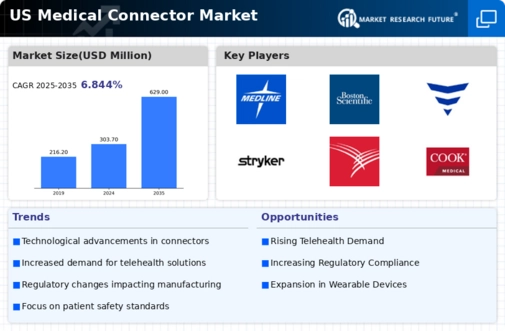Increased Focus on Telemedicine
the medical connector market is seeing growth driven by the rising focus on telemedicine. As healthcare systems adapt to provide remote consultations and monitoring, the need for reliable medical connectors becomes paramount. Telemedicine solutions often require connectors that facilitate seamless communication between devices and healthcare providers. The telehealth market is projected to reach $459 billion by 2030, underscoring the potential for growth in the medical connector market. This shift towards telemedicine necessitates the development of connectors that can support various telehealth applications, including remote patient monitoring and virtual consultations. Consequently, manufacturers are likely to invest in innovative connector designs that enhance the functionality and reliability of telemedicine devices.
Integration of IoT in Medical Devices
The integration of Internet of Things (IoT) technology into medical devices is transforming the landscape of the medical connector market. IoT-enabled devices require advanced connectors that can support data transmission and connectivity. As healthcare providers increasingly adopt IoT solutions, the demand for sophisticated medical connectors is expected to rise. The market for IoT in healthcare is projected to grow at a CAGR of 30% from 2021 to 2028, indicating a substantial opportunity for connector manufacturers. These connectors must not only ensure reliable connections but also comply with stringent data security standards. This trend suggests that the medical connector market will likely see innovations aimed at enhancing connectivity and data integrity, thereby improving overall patient outcomes.
Growth in Minimally Invasive Procedures
The medical connector market is positively influenced by the rising popularity of minimally invasive procedures. These procedures, which offer reduced recovery times and lower risk of complications, often rely on specialized medical connectors to ensure the functionality of surgical instruments and devices. The minimally invasive surgical market is anticipated to reach $50 billion by 2025, highlighting the increasing reliance on advanced medical technologies. As healthcare providers seek to improve patient outcomes, the demand for high-quality connectors that can withstand the rigors of surgical environments is likely to grow. This trend indicates that manufacturers in the medical connector market must prioritize the development of durable and efficient connectors tailored for minimally invasive applications.
Emphasis on Customization and Versatility
The medical connector market is increasingly characterized by an emphasis on customization and versatility. As healthcare providers seek tailored solutions to meet specific clinical needs, the demand for connectors that can be adapted for various applications is on the rise. This trend is particularly evident in the development of connectors that can accommodate different medical devices and technologies. The market for customized medical connectors is expected to grow significantly, driven by the need for improved compatibility and performance. Manufacturers are likely to focus on creating versatile connectors that can be used across multiple platforms, thereby enhancing their appeal in the medical connector market. This shift towards customization may lead to increased collaboration between manufacturers and healthcare providers to develop connectors that meet unique requirements.
Rising Demand for Home Healthcare Solutions
The medical connector market experiences a notable surge in demand due to the increasing preference for home healthcare solutions. As the population ages, more individuals require medical devices that facilitate at-home monitoring and treatment. This trend is reflected in the projected growth of the home healthcare market, which is expected to reach approximately $173 billion by 2026. Medical connectors play a crucial role in ensuring the seamless operation of these devices, thereby enhancing patient care. The shift towards home healthcare not only reduces hospital visits but also emphasizes the need for reliable and efficient medical connectors. Consequently, manufacturers are focusing on developing connectors that are compatible with a variety of home healthcare devices, which is likely to drive innovation and growth within the medical connector market.
















Leave a Comment